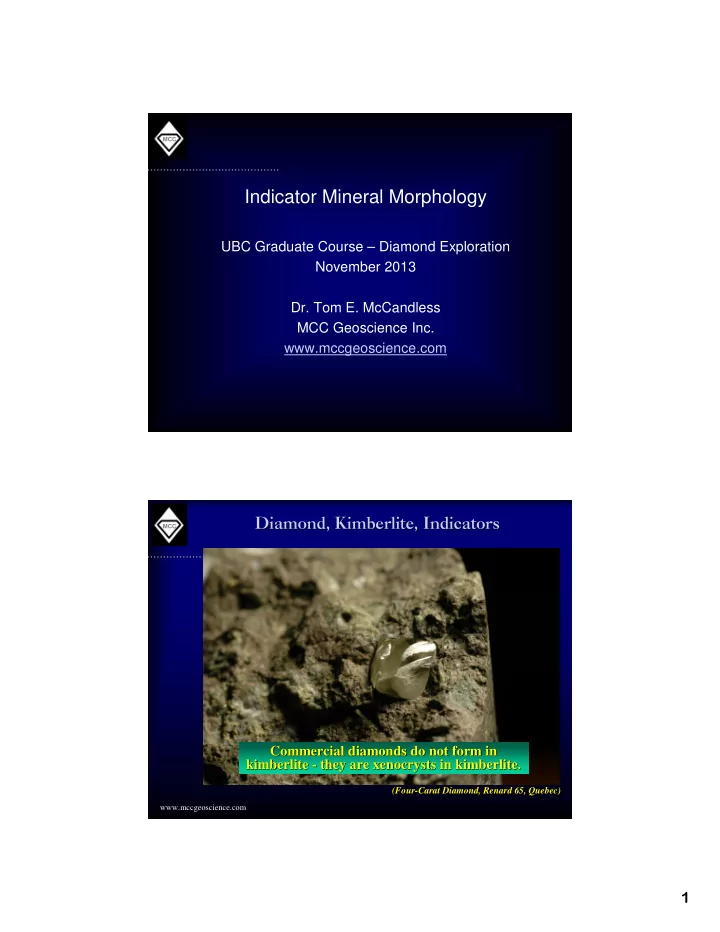

MCC Indicator Mineral Morphology UBC Graduate Course – Diamond Exploration November 2013 Dr. Tom E. McCandless MCC Geoscience Inc. www.mccgeoscience.com ������������������������������� ������������������������������� MCC Commercial diamonds do not form in Commercial diamonds do not form in kimberlite kimberlite - - they are xenocrysts in kimberlite. they are xenocrysts in kimberlite. (Four- -Carat Diamond, Renard 65, Quebec) Carat Diamond, Renard 65, Quebec) (Four www.mccgeoscience.com �
�������������������� �������������������� �������������������� �������������������� �������������������� �������������������� �������������������� �������������������� MCC peridotite parent rock eclogite parent rock eclogite parent rock peridotite parent rock omphacite forsterite pyrope-almandine pyrope Most diamonds originate in mantle peridotite Most diamonds originate in mantle peridotite and eclogite - and eclogite - the parent rocks of diamond. the parent rocks of diamond. www.mccgeoscience.com ����������� ������������������������� ������������������������ ���������� MCC D D isruption – the diamond parent rock is removed from its mantle stability field. D isaggregation – the diamond parent rock (xenolith) is physically broken apart and attacked by fluids in the igneous host rock (kimberlite) D issemination – diamonds, parent rock minerals (indicators) and parent rock fragments (xenoliths) are physically mixed into the igneous host rock. D ispersion – surviving indicator minerals are eroded from the igneous host by weathering, and by alluvial, fluvial, glacial, and/or marine processes. www.mccgeoscience.com �
��������������� �� ����� MCC crust 50 mantle depth, km 100 graphite diamond 150 200 kimberlite genesis 250 1 cm www.mccgeoscience.com �������������������������� MCC Mantle indicator minerals are Mantle indicator minerals are dispersed into the secondary dispersed into the secondary Erosion of 1.4 km Erosion of 1.4 km environment environment of kimberlitic material of kimberlitic material Present- -day surface of day surface of Present Kimberley pipes and Kimberley pipes and sills. sills. (after Hawthorne, 1975) (after Hawthorne, 1975) www.mccgeoscience.com �
!������ ���������������"������� !������ ���������������"������� MCC Quebec, Esker sampling Quebec, Esker sampling Brazil, Stream sediment sampling Brazil, Stream sediment sampling Indicator mineral sampling Indicator mineral sampling accounted for over 80% accounted for over 80% of kimberlite discoveries from of kimberlite discoveries from 1872 – 1872 – 1981 1981 Botswana, Deflation surface Botswana, Deflation surface sampling sampling www.mccgeoscience.com "����������������"��������# "����������������"��������#��"� ��"�$ $ MCC Cr- -diopside (CD) diopside (CD) Cr Cr- -spinel (chromite spinel (chromite) Cr peridotite garnet (p- -type) type) peridotite garnet (p eclogite garnet (e- eclogite garnet (e -type) type) Mg- Mg -Cr ilmenite ( Cr ilmenite (picro picro) ) unique appearance, high specific gravity, limited magnetic unique appearance, high specific gravity, limited magnetic susceptibility, susceptibility, ubiquitous in the mantle ubiquitous in the mantle www.mccgeoscience.com �
"����������������"��������#��"� "����������������"��������# ��"�$ $ MCC pressure, temperature pressure, temperature diamond cogenesis, diamond cogenesis, temperature temperature diamond cogenesis, diamond cogenesis, temperature temperature diamond cogenesis diamond cogenesis diamond preservation diamond preservation indicator minerals allow for prioritization of exploration indicator minerals allow for prioritization of exploration samples and igneous host rocks samples and igneous host rocks www.mccgeoscience.com ����������"�������"������� % ����������"�������"������� % MCC Assessment of the shape and surface features of indicators that are developed in the primary primary and secondary environments – secondary primary environment – the mantle parent primary rock and the igneous host rock; secondary environment – the near surface secondary (marine) and surface of the earth; weathering – physical and chemical transport – alluvial, fluvial, glacial, and marine. – with the goal of establishing proximity to source. www.mccgeoscience.com �
&��������������� %�#'������$ &��������������� %�#'������$ MCC Primary Environment Primary Environment Kelyphitic rim Kelyphitic rim – a mix of hydrous silicate and oxide minerals formed as a reaction product between the igneous host and the parent rock mineral. Sub- -kelyphitic surface kelyphitic surface – ‘orange peel’ texture on garnet Sub developed beneath the kelyphite. Reaction surface – dendritic texture on garnet along planes Reaction surface in the garnet. Sculpturing – dissolution along crystallographic planes that Sculpturing produce systematic pyramidal features. www.mccgeoscience.com &��������������� %�#'������$ &��������������� %�#'������$ &��������������� %�#'������$ &��������������� %�#'������$ &��������������� %�#'������$ &��������������� %�#'������$ &��������������� %�#'������$ &��������������� %�#'������$ MCC Secondary Environment Secondary Environment Weathering – (chemical) etching of the garnet Weathering surface. (physical) fracture due to stress release. Transport – frosting, pitting, abrasion, Transport conchoidal breaks. Both primary surfaces and secondary surfaces are modified in the secondary environment. www.mccgeoscience.com �
!���� ������������()*+ MCC � physical search of libraries (no � physical search of libraries (no GeoRef GeoRef) ) � gleaned from 181 public & private sources � gleaned from 181 public & private sources � 124 kimberlites, 15 countries � 124 kimberlites, 15 countries � � entered all mineral analyses to 1984: entered all mineral analyses to 1984: � � 4,002 garnets 4,002 garnets � � 976 chrome diopsides diopsides 976 chrome � � 949 chromites 949 chromites � 1,691 � 1,691 picroilmenites picroilmenites � � 326 other mineral analyses 326 other mineral analyses � also 3,519 minerals from � also 3,519 minerals from ‘ ‘non non- -kimberlite kimberlite’ ’ www.mccgeoscience.com !���� ������������()*+ MCC A total of A total of 11,463 analyses collected, 11,463 analyses collected, all data entered by hand. all data entered by hand. Linked reference, kimberlite, Linked reference, kimberlite, mineralogy, occurrence, association mineralogy, occurrence, association www.mccgeoscience.com �
����,()*+ MCC Mobil Oil buys out Superior Oil, dismantles the Superior Minerals Division. Data etc., were ‘discarded’ www.mccgeoscience.com ()*+�- )+)�.�������� MCC 80 70 60 Cr 2 O 3 wt % 50 40 30 20 10 0 0 2 4 6 8 10 12 14 16 18 20 MgO wt % (Supco Database) www.mccgeoscience.com �
����������������- /0�1//� !������ MCC kimberlites (n = 2017) kimberlites (n = 2017) 80 groundmass groundmass (n = 291) (n = 291) 70 xenoliths xenoliths (n = 409) (n = 409) 60 Cr 2 O 3 wt % 50 40 30 20 10 0 0 2 4 6 8 10 12 14 16 18 20 MgO wt % (Roeder Database; 1994) www.mccgeoscience.com 2�������� #��3�4/($ MCC inclusions in olivine inclusions in olivine 80 in basalts (n = 305) in basalts (n = 305) 70 60 Cr 2 O 3 wt % 50 40 30 20 10 0 0 2 4 6 8 10 12 14 16 18 20 MgO wt % (Roedder database, 1994) www.mccgeoscience.com �
Recommend
More recommend